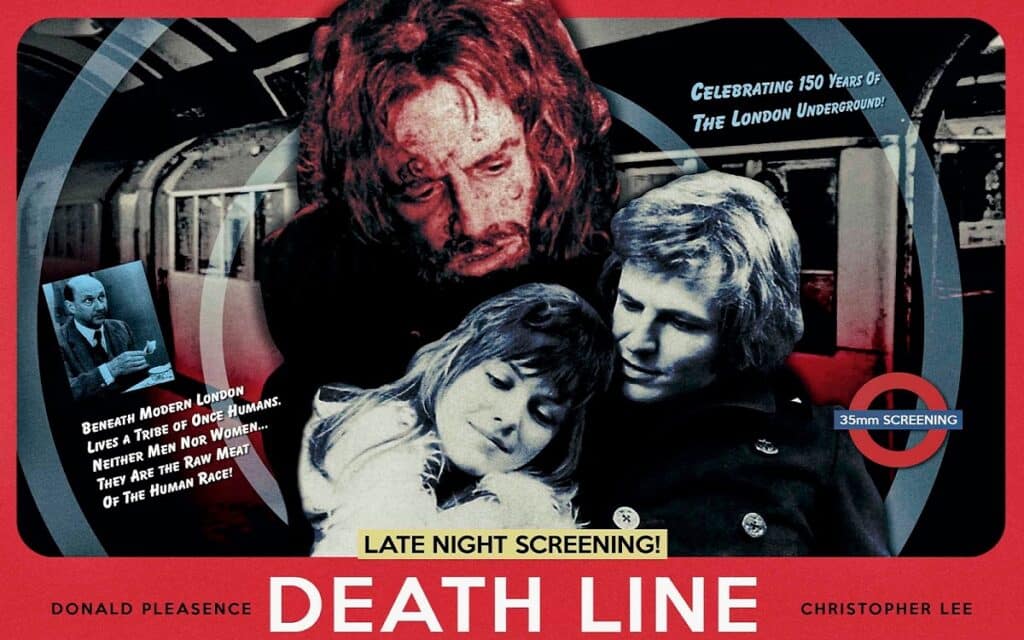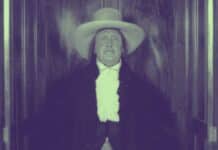Death Line aka Raw Meat is one of the most original British horror films of the early 1970s, says RICHARD PHILLIPS-JONES

TITLE: Death Line aka Raw Meat
YEAR RELEASED: 1972
DIRECTOR: Gary Sherman
CAST: Donald Pleasence; Norman Rossington, David Ladd; Sharon Gurney; Hugh Armstrong; Christopher Lee
Review of Death Line 1972
Unbeknownst to the majority of Londoners, there exists between the underground train stations of Holborn and Russell Square an abandoned network of tunnels which were part of an aborted stretch of line. A cave-in at the site in 1892 left many workers trapped, and left to die. Except… some survived.Fast forward to 1972, and a student couple spot a suited and bowler-hatted man lying at the steps off a railway platform. They alert a patrolling policeman, only to find that he has disappeared from sight in the meantime.
The case is taken on by Inspector Calhoun (Donald Pleasence), a cynical and somewhat world weary policeman of the old school. The missing man turns out to be one James Manfred OBE, a prominent civil servant. Calhoun’s initial investigation is interrupted by the appearance of a mysterious MI5 representative (Christopher Lee). However, the inspector evidently has little respect for authority figures, continuing his investigation regardless.
As Calhoun learns of the abandoned tunnels near the scene of the crime, the young couple (David Ladd and Sharon Gurney) make a discovery of their own. In the process, they get a little too close to the truth for comfort, particularly when it becomes clear that there were survivors from the cave-in many years ago, and they have been feeding on whatever they can get their hands on…
For a film made by Americans in Britain, Death Line is refreshingly free of any sentimental tourist views of London. The depiction of the capital here is altogether darker and somewhat seedy – Wil Malone’s electronic score sets the scene perfectly as James Cossins’ doomed government official surveys the nightlife of Soho while the opening credits play.
Visually, the film focuses heavily on interior details – there is little in the way of wide location shots. This approach makes for a claustrophobic experience, and first time director Gary Sherman (later to give us Dead And Buried and the ill-starred Poltergeist III) throws some original visual elements into the mix. A slow panoramic shot of the underground dwelling allows the viewer to soak up the dank and decaying atmosphere, panning across long-dead corpses and half-chewed, maggot-ridden flesh.
The film’s more graphic scenes were too much for the BBFC, which insisted on cuts before giving the film an X certificate. Trims were made to some brutal killings and an underground dweller feasting on a rat, as well as a scene of attempted rape. These were reinstated for a later DVD release, but even with cuts this was still pretty strong stuff for 1972.
The depiction of the police force was also unusual for the time, and they are not the whiter-than-white types usually seen on screen back in the day. Calhoun and his assistant Rogers (Norman Rossington) are interestingly prescient of the more complex cops of The Sweeney, which would debut on TV a few years later. Still, you can’t help liking the world weary and deadpan Inspector, thanks to the performance from the always reliable Pleasence.
Providing an intriguing bridge between the last days of the Brit-horror boom and the coming of the slasher film, Death Line remains one of the more original efforts of the period. Don’t be fooled by Christopher Lee’s prominent billing, though – he could well have shot his solitary scene within a day…
Read about Death Line’s fantastic soundtrack here on Spooky Isles!
Tell us your thoughts on Death Line 1972 in the comments section below!









